
一、介绍
Socket 模块可以用来进行数据传输,支持TCP和UDP两种协议。
本期将为您展示一下:
如何 使用 Socket模块实现 DAYU200开发板 和 Windows PC (SocketTool 工具)的之间的数据传输。
演示环境:
- OpenHarmony SDK API Version 8(3.1.5.5)。
- DevEco Studio 3.0 Beta3。
- Build Version: 3.0.0.900, built on March 30, 2022。
- Runtime version: 11.0.13+7-b1751.21 amd64。
二、开发步骤
1、权限声明
创建项目后,打开项目config.json 配置文件,在module内添加权限声明
"reqPermissions": [
{
"name": "ohos.permission.INTERNET" //socket权限
},
{
"name": "ohos.permission.GET_WIFI_INFO" //获取wifi地址权限
}
]
2、通过TCP协议方式实现
import需要的socket模块及辅助模块。
Logger是一个自定义的日志模块,方便快速记录和输出统一格式的日志。
import socket from '@ohos.net.socket';
//wifi模块,用于获取当前IP地址
import wifi from '@ohos.wifi';
//日志模块
import logger from '../common/Logger'
创建一个TCPSocket连接,返回一个TCPSocket对象。
//tcp连接对象
let tcp = socket.constructTCPSocketInstance();
//目标地址和端口
let targetAddr = {
address: '192.168.0.168',
family: 1,
port: 0 //7001/8001
}
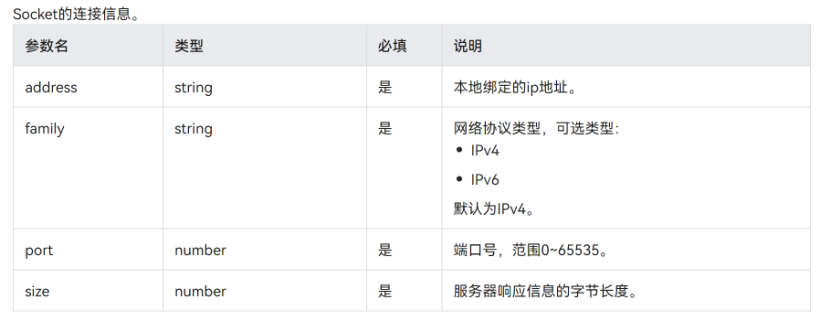
(可选)订阅TCPSocket相关的订阅事件。
订阅了connect 、message、close 事件。message事件的回调中可以获取接收到的数据,但是一个ArrayBuffer,需要通过resolveArrayBuffer函数进行进一步解析。
aboutToAppear() {
this.tcpInit()
}
tcpInit() {
tcp.on('connect', () => {
this.status = '已连接'
logger.getInstance(this).debug("on tcp connect success");
});
tcp.on('message', value => {
this.message_recv = this.resolveArrayBuffer(value.message)
logger.getInstance(this)
.debug(`on tcp message:${this.message_recv},remoteInfo:${JSON.stringify(value.remoteInfo)}`);
});
tcp.on('close', () => {
logger.getInstance(this).debug("on tcp close success");
});
}
//解析ArrayBuffer
resolveArrayBuffer(message: ArrayBuffer): string {
if (message instanceof ArrayBuffer) {
let dataView = new DataView(message)
logger.getInstance(this).debug(`length ${dataView.byteLength}`)
let str = ""
for (let i = 0;i < dataView.byteLength; ++i) {
let c = String.fromCharCode(dataView.getUint8(i))
if (c !== "\n") {
str += c
}
}
logger.getInstance(this).debug(`message aray buffer:${str}`)
return str;
}
}
绑定IP地址和端口,端口可以指定或由系统随机分配。
//本地地址和端口
let localAddr = {
address: this.resolveIP(wifi.getIpInfo().ipAddress),
port: 0
}
//bind本地地址
tcp.bind({ address: this.localAddr.address, port: 8000, family: 1 })
.then(() => {
logger.getInstance(this).debug(`bind tcp success`);
}).catch(err => {
logger.getInstance(this).error(`bind tcp failed ${err}`);
return
});
}
连接到指定的IP地址和端口。
Button('连接TCP')
.width('90%')
.height(80)
.margin({ top: 20 })
.type(ButtonType.Capsule)
.onClick(() => {
this.tcpConnect()
})
//连接TCP
tcpConnect() {
tcp.getState()
.then((data) => {
logger.getInstance(this).debug(`====${JSON.stringify(data)}`)
if (data.isClose) {
this.tcpInit()
}
//开始连接
tcp.connect(
{
address: { address: targetAddr.address, port: 8001, family: 1 }, timeout: 6000
}
).then(() => {
logger.getInstance(this).debug(`connect success`);
}).catch((error) => {
logger.getInstance(this).error(`connect failed ${JSON.stringify(error)}`);
})
})
}
发送数据。
Button('发送TCP消息')
.width('90%')
.height(80)
.margin({ top: 20 })
.type(ButtonType.Capsule)
.onClick(() => {
this.tcpSend()
})
//发送TCP消息
tcpSend() {
//查看状态
tcp.getState().then((data) => {
logger.getInstance(this).debug(`====${JSON.stringify(data)}`)
//已连接,就发送数据
if (data.isConnected) {
//发送消息
tcp.send(
{ data: this.message_send, }
).then(() => {
logger.getInstance(this).debug(`send success`);
}).catch((error) => {
logger.getInstance(this).error(`send failed ${JSON.stringify(error)}`);
})
} else {
logger.getInstance(this).error(`not connect`);
}
})
}
Socket连接使用完毕后,主动关闭。
Button('关闭TCP连接')
.width('90%')
.height(80)
.margin({ top: 20 })
.type(ButtonType.Capsule)
.onClick(() => {
this.tcpClose()
})
//关闭TCP连接
tcpClose() {
tcp.close().then(() => {
this.status = '已断开'
logger.getInstance(this).debug(`tcp.close success`)
}).catch((err) => {
logger.getInstance(this).error(`tcp.close error:${JSON.stringify(err)}`)
})
tcp.off('close');
tcp.off('message');
tcp.off('connect');
}
3、通过UDP协议方式实现
import需要的socket模块及辅助模块。
Logger是一个自定义的日志模块,方便快速记录和输出统一格式的日志。
import socket from '@ohos.net.socket';
//wifi模块,用于获取当前IP地址
import wifi from '@ohos.wifi';
//日志模块
import logger from '../common/Logger'
创建一个UDPSocket连接,返回一个UDPSocket对象。
//udp连接对象
let udp = socket.constructUDPSocketInstance();
//目标地址和端口
let targetAddr = {
address: '192.168.0.168',
family: 1,
port: 0 //7001/8001
}
(可选)订阅UDPSocket相关的订阅事件。
订阅了listening、message、close 事件。message事件的回调中可以获取接收到的数据,但是一个ArrayBuffer,需要通过resolveArrayBuffer函数进行进一步解析。
aboutToAppear() {
this.udpInit()
}
udpInit() {
udp.on('listening', () => {
logger.getInstance(this).debug("on udp listening success");
});
udp.on('message', value => {
this.message_recv = this.resolveArrayBuffer(value.message)
logger.getInstance(this)
.debug(`on udp message:${this.message_recv},remoteInfo:${JSON.stringify(value.remoteInfo)}`);
});
udp.on('close', () => {
logger.getInstance(this).debug(`on udp close success`);
});
}
//解析ArrayBuffer
resolveArrayBuffer(message: ArrayBuffer): string {
if (message instanceof ArrayBuffer) {
let dataView = new DataView(message)
logger.getInstance(this).debug(`length ${dataView.byteLength}`)
let str = ""
for (let i = 0;i < dataView.byteLength; ++i) {
let c = String.fromCharCode(dataView.getUint8(i))
if (c !== "\n") {
str += c
}
}
logger.getInstance(this).debug(`message aray buffer:${str}`)
return str;
}
}
绑定IP地址和端口,端口可以指定或由系统随机分配。
//本地地址和端口
let localAddr = {
address: this.resolveIP(wifi.getIpInfo().ipAddress),
port: 0
}
//bind本地地址
udp.bind({ address: this.localAddr.address, family: 1 })
.then(() => {
logger.getInstance(this).debug(`bind upd success`);
}).catch((err) => {
logger.getInstance(this).error(`bind upd failed ${JSON.stringify(err)}`);
})
}
发送数据。
Button('发送UDP消息')
.width('90%')
.height(80)
.margin({ top: 50 })
.type(ButtonType.Capsule)
.onClick(() => {
this.udpSend()
})
//发送UDP消息
udpSend() {
//查看状态
udp.getState().then((data) => {
logger.getInstance(this).debug(`====${JSON.stringify(data)}`)
//如果已关闭,就重新初始化
if (data.isClose) {
this.udpInit()
}
//已绑定,就发送数据
if (data.isBound) {
udp.send(
{
data: this.message_send,
address: { address: targetAddr.address, port: 7001, family: 1 }
}
)
.then(() => {
logger.getInstance(this).debug(`send success`);
})
.catch((error) => {
logger.getInstance(this).error(`send failed ${typeof error.code}`);
})
}
})
}
Socket连接使用完毕后,主动关闭。
Button('关闭UDP')
.width('90%')
.height(80)
.margin({ top: 20 })
.type(ButtonType.Capsule)
.onClick(() => {
this.udpClose()
})
udpClose() {
udp.close().then(() => {
logger.getInstance(this).debug("udp.close success");
}).catch((err) => {
logger.getInstance(this).error(`udp.close error:${JSON.stringify(err)}`)
})
udp.off('message');
udp.off('listening');
udp.off('close');
}
三、效果展示
windows系统上打开SocketTool 工具,分别创建TCP Server、UDP Server,监听端口分别为8001、7001。
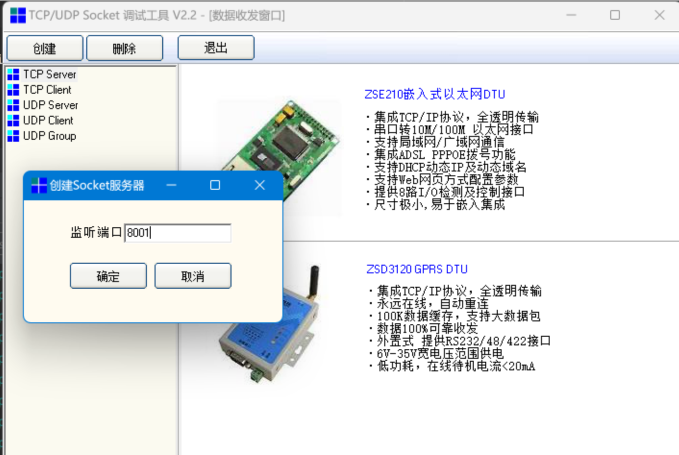
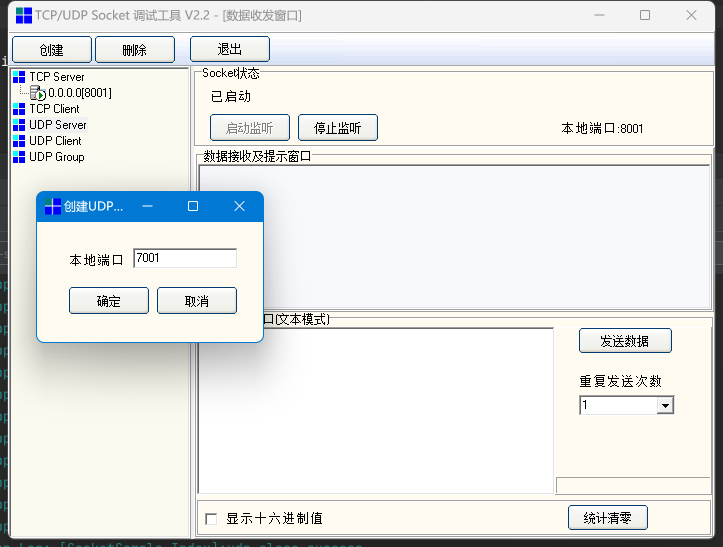
点击,DAYU200开发板应用上 “连接” 按钮,Socket工具显示已连接。
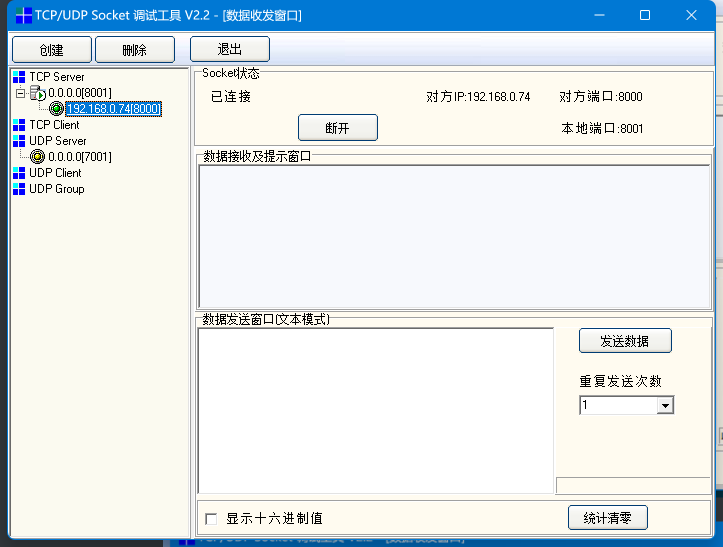
点击 DAYU200开发板应用上 “发送TCP消息” 按钮,Socket工具显示接收到的消息。
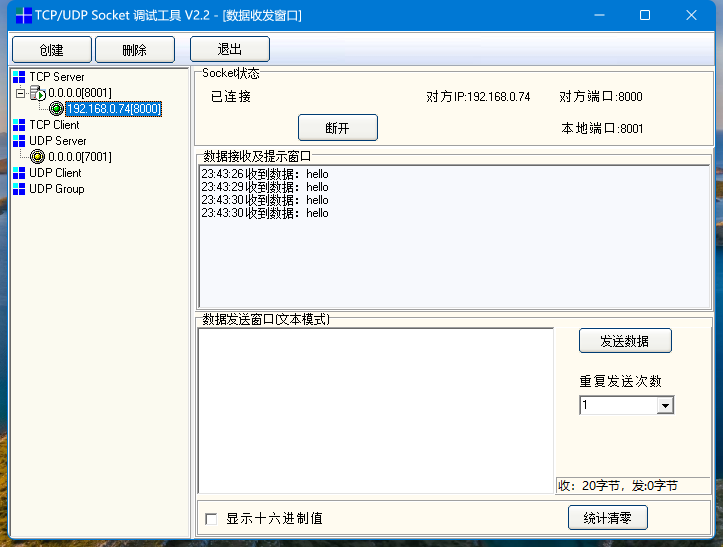
Socket工具上输入要回复的消息,点击 “发送数据” 按钮。
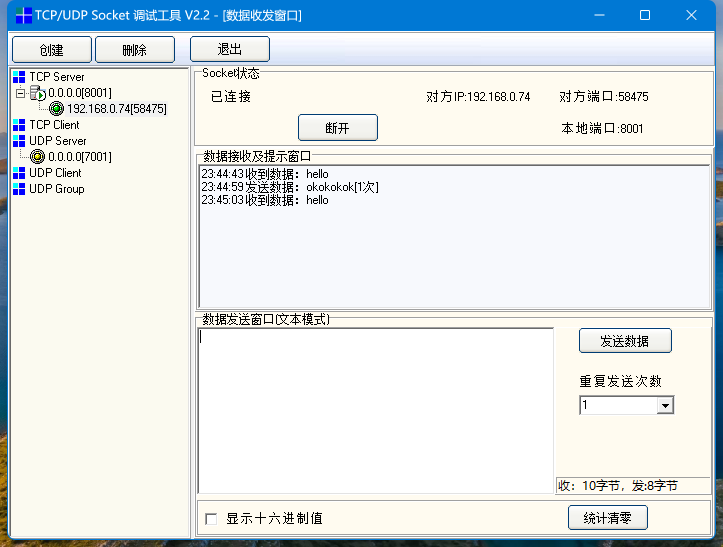
点击 DAYU200开发板应用上 “发送UDP消息” 按钮,Socket工具UDP Server 栏 显示接收到的消息。
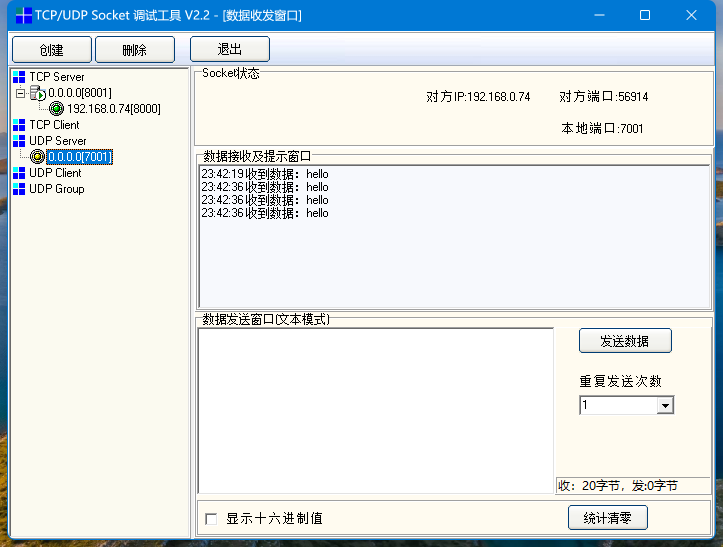
Socket工具上输入要回复的消息 ,点击 “发送数据” 按钮。
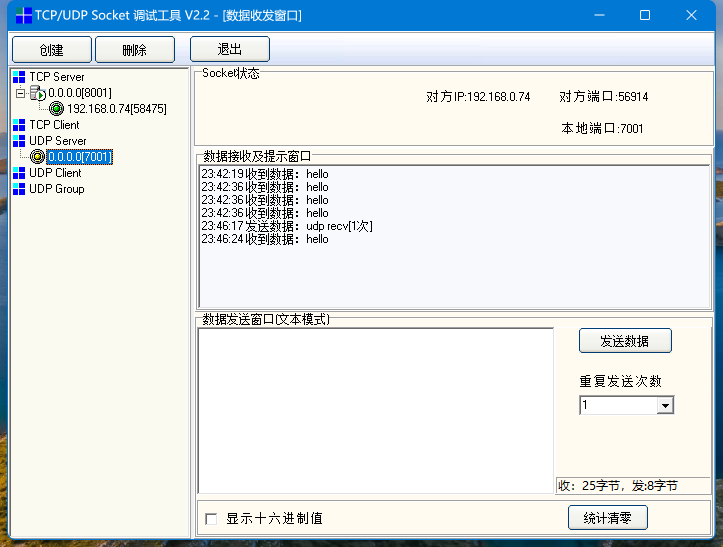
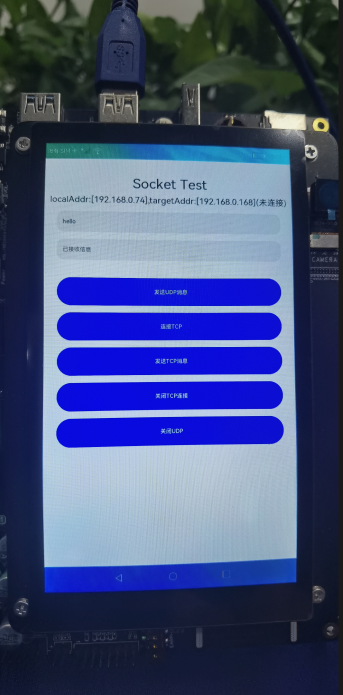
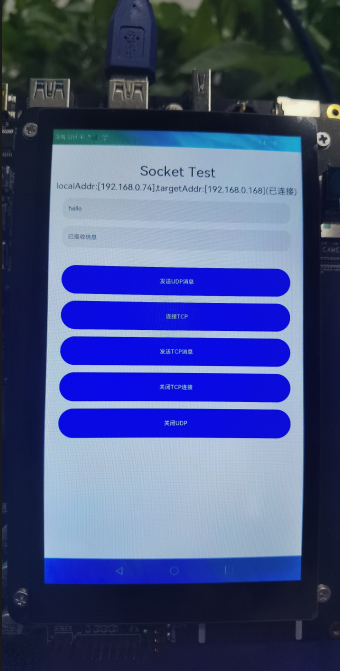
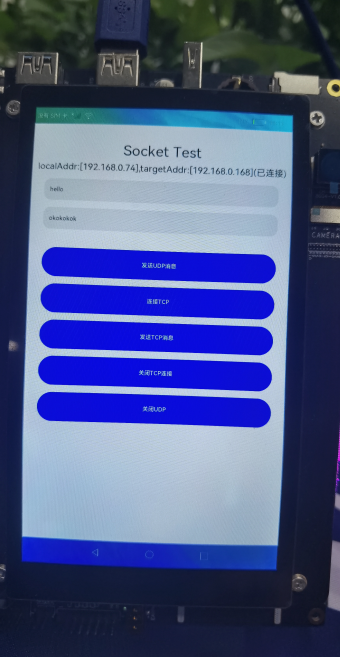
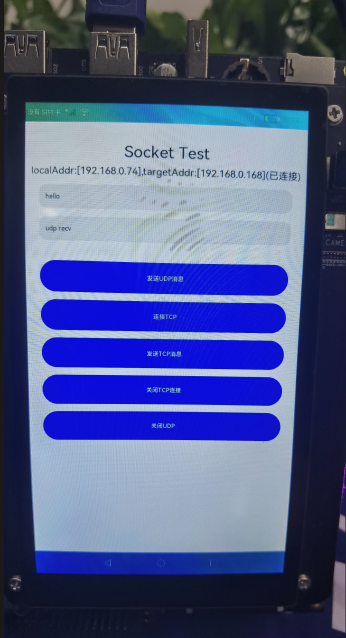
四、思考总结
TCP是面向连接的协议,在收发数据前必须和对方建立可靠的连接,UDP是一个面向无连接的协议,数据传输前,源端和终端不建立连接,所以TCP的方式比UDP多一个connect的过程。
getState接口的状态值有3个,isBound、isClose 是udp/tcp 都会用,isConnected是给tcp用的 。{“isBound”:true,“isClose”:false,“isConnected”:true}
用Socket 工具回复消息后,DAYU200侧如果要显示接收到的消息,需要再发送一次消息。
五、参考资料
1、HarmonyOS API参考。
https://developer.harmonyos.com/cn/docs/documentation/doc-references/js-apis-net-socket-0000001144636978。
2、OpenHarmony Gitee 样例指导。
https://gitee.com/openharmony/docs/blob/master/zh-cn/application-dev/connectivity/socket-connection.md。
 蜀ICP备20004578号
蜀ICP备20004578号